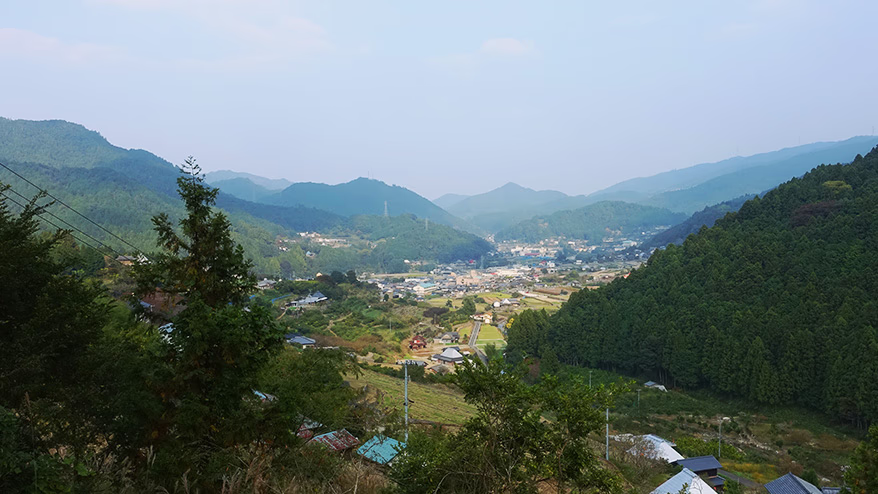プロデュース部 部長の真鍋太一です。
2014年3月より妻と子供二人と徳島県にある人口6,000人の神山町で暮らしています。
所属するプロデュース&デザイン部では、企業活動を通じて、デザインやアートのクリエイティブな力で社会と共有できる価値をつくり出すことを目的に活動しています。
地方創生で活気づく日本の地方。その中でもモデル地域として注目される徳島県神山町。神山での『仕事と暮らし』を通じて、地域とのつながりや「暮らすように働く」ことが企業の価値づくりにどう役立っていくかを、自分と家族、モノサスの神山での活動を実験台にお伝えしていきます。
神山と出会うきっかけ
初回ということもあり、まずは個人的な話を書きます。
3年前のちょうど今くらいの時期に、神山町の視察から戻った社長の林から「神山を知っているか。そこで何かやりたいのだけど今度一緒に行ってみないか?」と言われたのを覚えています。
私が神山を知ったのは2008年にさかのぼります。
私の人生に大きな影響を与えている『自分の仕事をつくる』の著者の西村佳哲さん。今の神山になるひとつのきっかけを作ったであろう「イン神山」というWEBサイトのプランニング・ディレクションを彼が手がけ、そのプロジェクトの取材記事を読み神山のことを知りました。
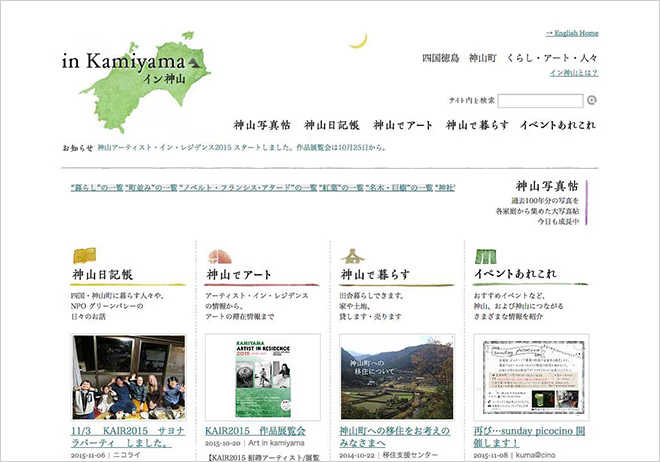
アーティストが3ヶ月間滞在しながら作品制作をする、アーティスト・イン・レジデンスという活動を長年実施してきた神山でしたが、WEBサイトに加え「ワーク・イン・レジデンス」という言葉も、短い滞在期間中に西村さんが生み出したと後で知りました。
田舎に仕事がないなら仕事がある人に仕事を持ってきてもらって、滞在しながら働いてもらおうというのが基本的な考え方。その「ワーク(働く)」という言葉との西村さんの向き合い方は、「イン神山」というサイトはもとより、今の神山の動きそのものの根っこを表現しているなと個人的には思っています。
神山のことを知ってはいたものの訪れる機会がないままだった私は、娘が小学校に上がるタイミングで、次に引っ越すなら自分の故郷もある四国はありだなぁ、となんとなく考え始めていたので、これもめぐり合わせだなと思い、社長の林と神山を訪れました。
神山に移住した理由

自宅となりの映像制作会社(絶賛営業中)の縁側で過ごす子供たち。自由すぎ...汗
最初に神山を訪れてから、高知の食文化や香川の美しい島々、実家がある愛媛などに浮気心も少し持ちながら、妻子を神山に置き去りにした10日間夏の「おためし移住」を経て、約1年半後に神山に引っ越しています。(おためし移住の妻の体験談(PDF))
「やっぱり子育てを神山みたいに自然がある田舎でしたいからですか?」と移住した理由をよく聞かれます。
理由は2つあります。
ひとつ目は、「暮らすように働く大人」と子供たちがふれ合う機会が多いから。
世の中は、働く大人たちに支えられて成り立っていますが、東京などの都心部ではあくまでもその人たちはお金を払ってサービスを提供してくれる「誰か」であることが多いと思います。親の職業や社交性の度合いにもよりますが、地域の子供たちが近所の飲食店のおじさんやスーパーのおばちゃんの手伝いをちょっとしたり、その人達と一緒に食事することなどはあまりないと思います。
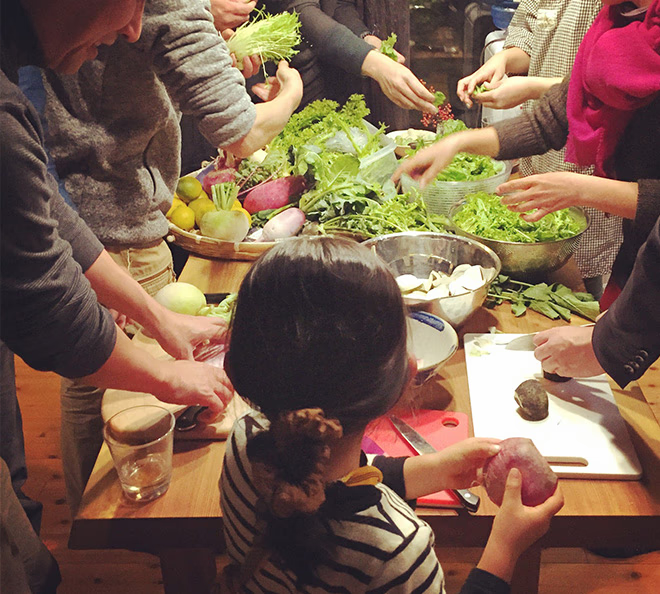
私たちの子供は、1年間で何人の大人と一緒にご飯を食べているでしょう。役場の人や農家さん、ベンチャー企業の経営者など、子供も大人も一緒にみんなで料理して食べます。
都会では、子供が成長する過程でふれ合う大人の数が少ないな、と思っています。もちろん田舎でも同じことが家庭によっては言えるのですが、特に神山では、働くことと暮らすことが重なり合い、たくさんの「暮らすように働く大人」たちとふれ合う機会がとにかく多いと思います。そんな暮らしの中で、みんなに育ててもらえることが子供たちにとって良いことだと思っています。
ふたつ目は、その「暮らすように働く大人」に自分たちもなれる可能性があるから。
モノサスでは、働き方と暮らし方、お金の稼ぎ方と使い方、その両方のモノサシを持とうと言っています。たくさんのお金を稼ぎ、使うことが、よりよい暮らしを得ることとイコールではないと言うことです。
政府が掲げる「まち・ひと・しごと創生総合戦略」の流れのなかで、今年の夏頃から神山町とのワーキンググループに参加しています。
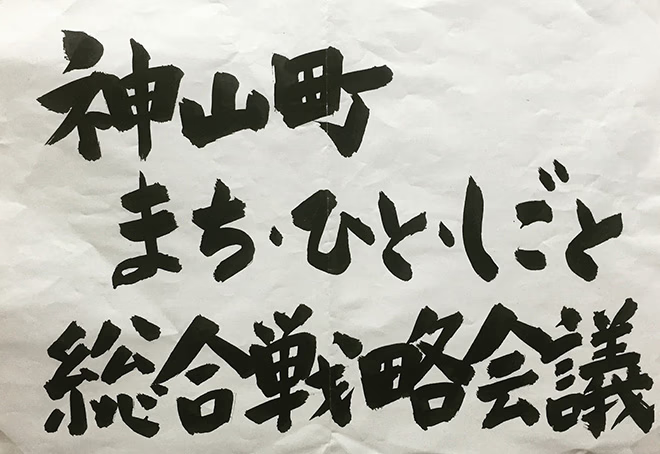
働くことと、暮らすこと、そして町にかかわることが密接に関わりあう多様な働き方をする大人が多い神山で、モノサスにおけるこの『仕事と暮らし』の実験を通じて、暮らすように働ける場所をまずはモノサスのメンバーと育てていけたらと思っています。
これからの
神山でのモノサス
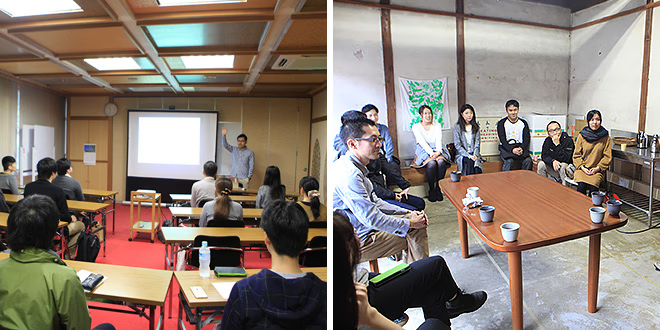
2015年11月9日におこなわれたモノサス版「神山塾」の開校式と真鍋家の土間(改装中)での塾生の自己紹介タイムの様子。
家族で移住して1年半以上が経ちましたが、まだモノサスとしての神山での活動は、始まったばかりです。来年に向けて色々な準備を始めていますが、今年の神山での目玉は、NPO法人グリーンバレーの理事でもあるリレイションの祁答院さんと一緒に、求職者支援制度の一環としてはじまったモノサス版「神山塾」ではないでしょうか。
神山で暮らしながらWEBの基礎的な技術を学ぶプログラムですが、3年前にはじめて神山を訪れてから、モノサスとしてきちんと地域と人と関わることができたはじめてのプロジェクトです。
この「神山ものさす塾」(勝手に命名)をきっかけに、来年から少しずつ新たな展開をご報告していけたらと思います。モノサスのサテライトオフィスの開設や、地域の食文化を守り育てるプロジェクトなど、モノサスはWEBの制作会社ではありますが、『仕事と暮らし』の実験を通じてその活動の幅を広げ、より地域と社会と一緒に働けるチームになっていけたらと思っています。
